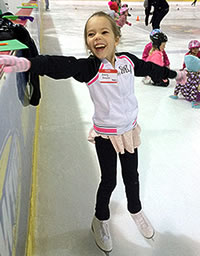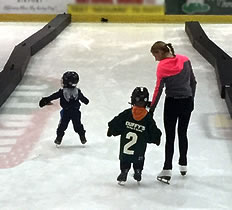

Learn to Skate Levels:
Snowplow 1-4
Basic Skills 1-6
Aspire Freeskate
Hockey (Termites, Mites)
Beginner Adults
The Bismarck Figure Skating Club teaches the fundamentals of figure skating through the U.S. Figure Skating “Learn to Skate” Program (formerly called “Basic Skills”). It’s simply the best way to take to the ice!
The purpose of the Learn to Skate Program is to take skaters from the beginning stages of skating to the point where they are capable of participating in the official higher-level Advanced program that follows USFS testing and competitive criteria recognized nationwide. We also offer Hockey Power Skating lessons for beginning hockey players who want to work on their skating skills.
The objectives of the Learn to Skate Program are: to provide a fun and safe skating experience; to teach correct techniques of the basic elements of skating; to develop a finer degree of coordination and balance; to promote physical fitness; and to have fun! For more information, see Class Descriptions and Frequently Asked Questions.
For questions about the Learn to Skate Program, please contact:
Laurey Hyland
Interim Learn To Skate Director
elm3skate@gmail.com
Frequently Asked Questions
What ages do you teach?
We teach toddlers as young as age 3 and adults at any age!
Where can I rent or buy skates?
You can purchase skates at Duffy’s Sports (Washington St. and Front St) or Scheels Sports in Kirkwood Mall. Our club also holds “skate swaps” on occasion. Skate rental is an option during public open skating at the Capital Ice Complex.
What kind of skates are best?
Figure skates or hockey skates. Good brands of figure skates are Riedell or the Jackson Mystique model. For anything beyond very early beginners, we recommend skates that lace (no velcro). For participation in performances or competitions, an all white (for girls) or all black (for boys) skate is recommended.
How should figure skates fit?
Like a glove! Skates shouldn’t be too small or too big. Toes shouldn’t have to curl to fit in the skate nor should they have an inch or two of growing room. Thin nylons or thin dress socks should be worn instead of thick fuzzy socks. The best way to see if figure skates fit properly is to take out the inner liner. Have the skater stand on the liner with their heel all the way back and see how much room is left in front of the toes. There should be no more than half an inch left.
Why are skates that are too big a problem?
Skates that are too big do not offer the ankle support where it is supposed to be. That puts the weight of the skater farther back and makes them catch and trip on their toe picks more. In addition, if the skates are a good supportive pair and they are too big, they may cause blisters and other possible foot injuries.
How should I tie a figure skate?
Tighten up the laces in the first half of the boot. Work up from the toe to the ankle. Don’t pull the laces too tight in this area. Just make sure that each pull is somewhat secure. Tighten the laces the most where the foot and the ankle bends. This is the most important part of lacing figure skates. Give the laces a good tug at this point and pull hard. Next, lace around the hooks. Make a criss-cross pattern with the laces and pull with both hands around each hook. Some skaters like to put the laces over and under the hooks; others like to put the laces under and then over. Either option is correct.
Tips
- If the skates don’t feel secure after being laced up, the laces are too loose, and lacing should be done over again.
- Figure skates should not be too tight. If a skater can’t bend his or her knees, the skates are too tight.
- Make sure the tongue of the skate is straight and does not slip under the laces.
- Skates must fit. If the boot is too big, lacing the skates tightly will not improve the ice skating experience
- Wear a sock that fits and make sure that no wrinkles are in the sock as the foot is placed inside the ice skating boot. Wearing thick socks is not recommended for figure skating.
Where should I get skates sharpened?
Contact Travis Wilson at 701-426-5018. Join the Bismarck Figure Skating Club Facebook page for information when Travis will be sharpening skates.
Where can my skater walk with skates on?
Rubber mats and carpeting ONLY. Do not walk on cement or the metal bleachers unless you have hard rubber guards protecting your blades.
How should skates be stored?
In a bag with soft cloth guards (called “soakers”) on the blades. DO NOT LEAVE hard rubber guards on blades as this will cause them to rust.
Is outdoor skating good or bad?
Both! It is good because it provides extra practice. It is bad because the ice surfaces aren’t always clean. Outdoor ice is really hard on skate blades. If you skate outdoors before you skate indoors you need to get your skates sharpened.
What should my skater wear?
Wear warm, insulating but lightweight clothing that is close-fitting; no scarves or other clothing that could be a safety hazard. Also wear lightweight gloves or mittens. A helmet or other head protection is recommended for beginners and encouraged for all ages.
Where should my skater get ready for lessons?
If your lesson is on Sunday night at VFW 1, you can go to the downstairs lobby behind the steps, or use one of the locker rooms. If your lesson is at Schaumberg Arena on Thursday nights, you can get ready in the front lobby or in one of the locker rooms behind the player benches.
Where can I find the dates and times of lessons if I have misplaced my schedule?
Lesson times and class dates are listed on this website in the Learn to Skate section. If you have registered for ice times through EntryEeze, you can also log into your account and click on “My Calendar” to see your schedule.
What does my hockey skater need for the first class?
Beginners to the hockey power skating class need hockey skates and a certified, ice-approved hockey helmet. These hockey classes are taught without a puck.


